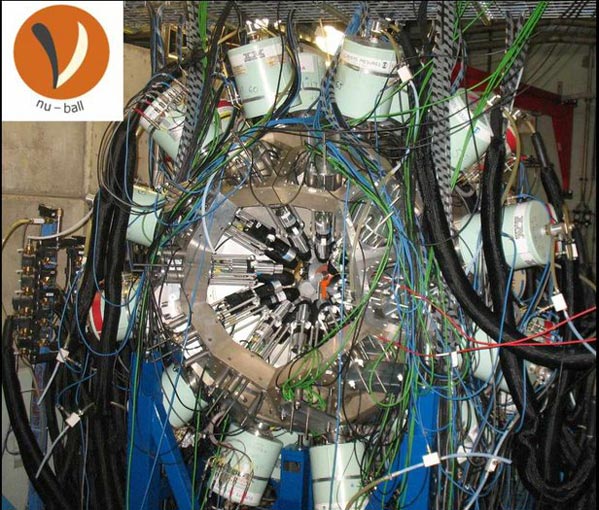New insights into the mechanism of nuclear fission

Das „nu-ball“ Gamma-Spektrometer am Experiment in Orsay. Anhand der emittierten Gammastrahlen ließ sich messen, wann die Fragmente der Kernspaltung ihren Eigendrehimpuls erhalten. © Nigel Warr
Nuclear physicists at the University of Cologne have contributed to an international research collaboration to show the way the spin of the two fragments, resulting from the splitting of an atomic nucleus, is generated / publication in Nature.
A series of experiments at the ALTO particle accelerator facility in Orsay, France, has revealed that the fragments resulting from nuclear fission obtain their intrinsic angular momentum (or spin) after fission, not before, as is widely assumed. This result was made possible by the ‘nu-ball’ collaboration, an international group of nuclear physicists aiming to study a wide range of nuclei and their structure.
The group includes researchers from 37 institutes and 16 countries – among them scientists from the University of Cologne’s Institute of Nuclear Physics (IKP) – and is led by the Irène-Joliot-Curie Laboratory in Orsay. The results are presented in the newly-published article ‘Angular momentum generation in nuclear fission’ in Nature.
Nuclear fission, in which a heavy nucleus splits in two and releases energy, was already discovered at the end of the 1930s by the chemists Otto Hahn and Fritz Strassmann, and the physicists Lise Meitner and Otto Frisch. However, open questions about the process persist to this day. The new scientific study addresses the question of why, when a heavy atomic nucleus fissions, the resulting fragments are observed to emerge spinning, even when the original nucleus did not spin at all. There are many competing theories, but the majority state that the spin of the fission fragments is generated before the nucleus splits, leading to a clear correlation of the spins of the two partner fragments.
To reveal the mechanism generating fragment spin, the team induced nuclear fission reactions at the ALTO facility and measured gamma rays, which are emitted in the process. Specifically, they irradiated samples of the uranium isotope 238U and the thorium isotope 232Th with a pulsed neutron beam. The experiments were performed from February until June 2018 with more than 1200 hours of beamtime at the particle accelerator. From Cologne, Rosa-Belle Gerst, Guillaume Häfner, Dr Nigel Warr and Dr Andrey Blazhev contributed to the preparation of the experiment, participated in the measurements, analysed selected data and contributed to the scientific discussion.
The new comprehensive data shows that the spin in fission is actually generated after the nucleus splits. This is indicated by analysis of the measured gamma rays. The experiments showed that the average spin has a saw-tooth dependence on the fragment mass. However, the two fragments, which can split in different mass ratios, have average spins which do not appear to depend on the mass of their partner fragment.
The main author of the study, Dr Jonathan Wilson from the IJC Laboratory in Orsay, said: ‘What really surprised me was the lack of significant dependence of the average spin observed in one fragment on the minimum spin demanded in the partner fragment. Most theories hypothesizing that spin is generated before fission would have predicted a strong correlation. Our results show that the fragment spin emerges after the splitting. It can be illustrated with by the snapping of a stretched elastic band which results in a turning force, or torque.’
Dr Nigel Warr remarked: ‘A major step towards the current experiment was a previous one at ALTO using 24 MINIBALL high-resolution gamma-detectors, which were developed in Cologne.’ Dr Andrey Blazhev added: ‘This led to the development of the multi-detector spectrometer “nu-ball”, consisting of 164 detectors. With this instrument, it was possible to measure gamma rays with high-resolution and higher efficiency than before.’
These new insights into the role of angular momentum in nuclear fission are important for the fundamental understanding and theoretical description of the fission process. However, they also have consequences for other research areas, such as the study of the structure of neutron-rich isotopes and the synthesis and stability of super-heavy elements.
Moreover, there are implications for practical applications such as the gamma-ray heating problem in nuclear reactors. The number of gamma rays emitted in nuclear fission (i.e. gamma multiplicity) is an important parameter for calculating the heating in nuclear reactors. The gamma multiplicity was measured directly by the research team, enabling more precise calculations of heating in nuclear reactors.
The Institute of Nuclear Physics at the University of Cologne has a long-standing collaboration with several nuclear physics groups at Orsay, and has contributed expertise on gamma-detectors as well as data analysis and nuclear structure interpretation.
Media Contact:
Dr Andrey Blazhev
a.blazhev@ikp.uni-koeln.de
Dr Nigel Warr
warr@ikp.uni-koeln.de
Press and Communications Team:
Eva Schissler
+49 221 470 4030
e.schissler@verw.uni-koeln.de
Publication:
https://www.nature.com/articles/s41586-021-03304-w
DOI: 10.1038/s41586-021-03304-w
More Information:
Institute for Nuclear Physics (UoC): www.ikp.uni-koeln.de/
IJC Lab: www.ijclab.in2p3.fr/en/home/
Media Contact
All latest news from the category: Physics and Astronomy
This area deals with the fundamental laws and building blocks of nature and how they interact, the properties and the behavior of matter, and research into space and time and their structures.
innovations-report provides in-depth reports and articles on subjects such as astrophysics, laser technologies, nuclear, quantum, particle and solid-state physics, nanotechnologies, planetary research and findings (Mars, Venus) and developments related to the Hubble Telescope.
Newest articles

Self-Destructing Cancer Cells: Cutting-Edge RNA Breakthrough
Jülich scientists use novel RNA technology to selectively switch off tumours in the brain. An Adaptable Platform Technology That Destroys Glioblastoma Cancer Cells Using a special RNA molecule, a team…

Endurance Training: Transforming Lives of Heart Failure Patients
Can strength and endurance training be beneficial for patients with a certain form of heart failure? A research team from Greifswald investigated this question together with seven other research centers…

A Wake-Up Call for Mediterranean Shark Protection Against Extinction
Overfishing, illegal fishing and increasing marketing of shark meat pose significant threats to the more than 80 species of sharks and rays that inhabit the Mediterranean Sea, according to a…



